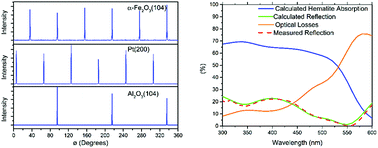Heteroepitaxial hematite photoanodes as a model system for solar water splitting
Abstract
Heteroepitaxial multilayer Pt(111)/Fe2O3(0001) films were deposited on sapphire c-plane (0001) substrates by RF magnetron sputtering and pulsed laser deposition, respectively. The films were highly crystalline, displaying an in-plane mosaic spread of less than 1° and a homogenous surface morphology with roughness of ∼3 Å. Ellipsometry and UV-vis spectroscopy measurements were shown to be in excellent agreement with modelling, demonstrating that the optics of the system including absorption in the hematite layer are well described. For polycrystalline hematite photoanodes deposited on platinum, full characterization of the system is hampered by the inability to make measurements in alkaline electrolyte containing hydrogen peroxide (H2O2) due to spontaneous decomposition of H2O2 by the exposed platinum. The pin-hole free high quality of the heteroepitaxial films is demonstrated by the ability to make stable and reproducible measurements in H2O2 containing electrolyte allowing for accurate extraction of charge separation and injection efficiency. The combination of excellent crystalline quality in addition to the well characterized optics and electrochemical properties of the heteroepitaxial hematite photoanodes demonstrate that Al2O3(0001)/Pt(111)/Fe2O3(0001) is a powerful model system for systematic investigation into solar water splitting photoanodes.

- This article is part of the themed collection: Water splitting and photocatalysis

 Please wait while we load your content...
Please wait while we load your content...